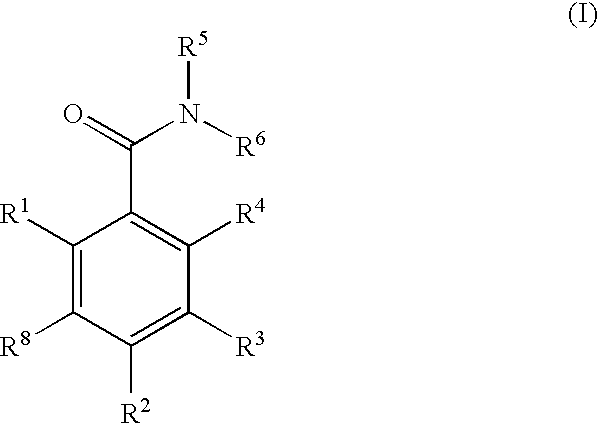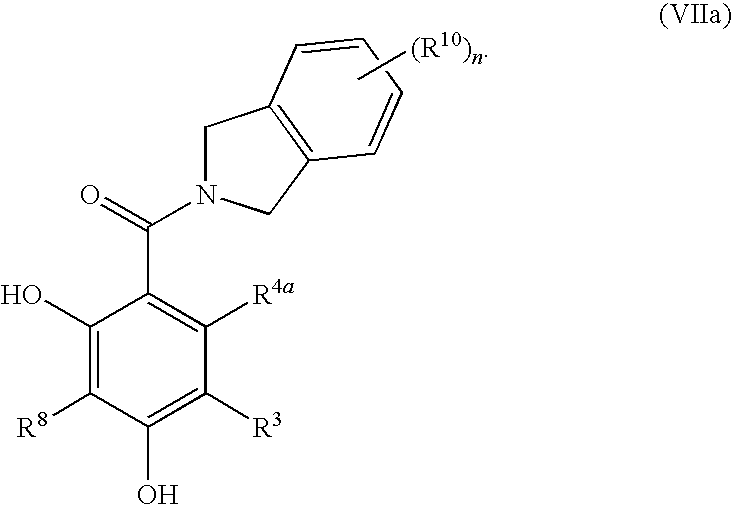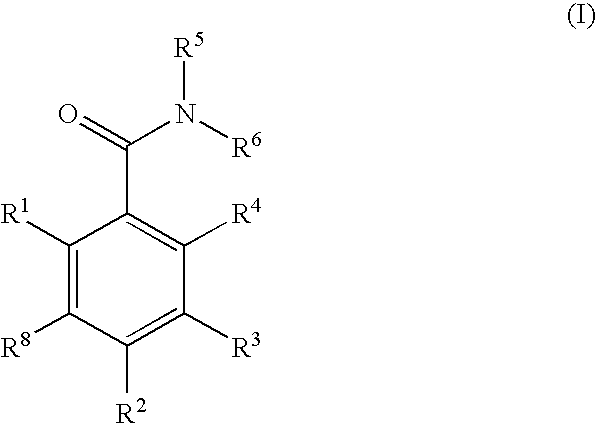Dihydroxyphenyl isoindolylmethanones
a technology of dihydroxyphenyl isoindolylmethanone and dihydroxyphenyl isoindolylmethanone, which is applied in the direction of heterocyclic compound active ingredients, biocide, drug compositions, etc., can solve the problem of increasing the production of non-native or mutant proteins, increasing the need for chaperones, and g2/m arrest is generally less well tolerated by cells
- Summary
- Abstract
- Description
- Claims
- Application Information
AI Technical Summary
Problems solved by technology
Method used
Image
Examples
examples 1 to 67
[1089]By following the methods described above, the compounds of Examples 1 to 67 set out in the Table below were prepared.
ExampleNumberCompoundChemical NameMethodN.M.R. DataM.S. 1N,N-Diethyl-2- hydroxy-5- methoxy- benzamideA1. From 2- hydroxy-5- methoxy- benzoic acid and diethylamine1H NMR (DMSO-d6) 9.13 (1 H, s), 6.77 (2 H, s), 6.60 (1 H, s), 3.67 (3 H, s), 3.38 (2 H, br m), 3.15 (2 H, br m), 1.05 (6 H, br m) MS: [M + H]+ 224 25-Chloro-N,N- diethyl-2- hydroxy- benzamideA1. From 5- chloro-2- hydroxy- benzoic acid and diethylamine1H NMR (DMSO-d6) 10.79 (1 H, s), 8.04 (1 H, dd), 7.88 (1 H, d), 7.68 (1 H, d), 4.23 (2 H, br m), 3.91 (2 H, br m), 1.92 (3 H, br m), 1.82 (3 H, br m)MS: [M + H]+ 228 33-Chloro-N,N- diethyl-4- hydroxy- benzamideA1. From 3- chloro-4- hydroxy- benzoic acid and diethylamine1H NMR (DMSO-d6) 10.53 (1 H, br s), 7.32 (1 H, d), 7.17 (1 H, dd), 6.97 (1 H, d), 3.30 (4 H, br m), 1.10 (6 H, t)MS: [M + H]+ 228 45-tert-Butyl-N,N- diethyl-2- hydroxy- benzamideA1. From 5...
example 68
Synthesis of (5-chloro-1,3-dihydro-isoindol-2-yl)-(2,4-dihydroxy-5-isopropyl-phenyl)-methanone
[1090]
[1091]A solution of 2,4-bis-benzyloxy-5-isopropyl-benzoic acid (0.451 g, 1.2 mmol), EDC (0.276 mg, 1.44 mmol), HOAT (0.196 mg, 1.44 mmol), triethylamine (0.5 ml, 3.6 mmol) and 5-chloro-2,3-dihydro-1H-isoindole (0.187 g, 1.2 mmol) (Preparation C3) in DMF (5 ml) was stirred at room temperature for 16 hours, then evaporated under vacuum. The crude material was dissolved in ethyl acetate and extracted twice with saturated NaHCO3, organics washed with water three times, then evaporated under vacuum to give 0.5 g of 2,4-bis-benzyloxy-5-isopropyl-phenyl)-(5-chloro-1,3-dihydro-isoindol-2-yl)-methanone. MS: [M+H]+ 512
[1092]Boron trichloride (1M in DCM) was added dropwise to a solution of 2,4-bis-benzyloxy-5-isopropyl-phenyl)-(5-chloro-1,3-dihydro-isoindol-2-yl)-methanone (0.5 g, 0.97 mmol) in dry DCM (10 ml) at 0° C. under nitrogen, then stirred for at 0° C. 1 hour warmed to room temperature a...
example 69
Synthesis of [1-(2,4-dihydroxy-5-isopropyl-benzoyl)-piperidin-4-yl)]-acetic acid
[1093]
[1094][1-(2-4-Dihydroxy-5-isopropyl-benzoyl)-piperidin-4-yl]-acetic acid ethyl ester (See Example 98) (80 mg, 0.23 mmol), was dissolved in THF (5 ml), MeOH (2.5 ml), H2O (2.5 ml), treated LiOH.H2O (40 mg), then stirred at room temperature for 15 hours. Reaction neutralized with 2N HCl then evaporated. The crude material was purified by flash column chromatography eluting with 12-100% MeOH / DCM followed by trituration with EtOAc to afford 45 mg of the title compound. MS: [M+H]+ 322. 1H NMR (Me-d3-OD) 6.96 (1H, s), 6.33 (1H, s), 4.24-4.12 (2H, m), 3.23-3.13 (1H, m), 3.04-2.93 (2H, m), 2.26 (2H, d), 2.10-1.99 (1H, m), 1.85-1.76 (2H, m), 1.36-1.24 (2H, m), 1.19 (6H, d)
PUM
 Login to View More
Login to View More Abstract
Description
Claims
Application Information
 Login to View More
Login to View More - R&D
- Intellectual Property
- Life Sciences
- Materials
- Tech Scout
- Unparalleled Data Quality
- Higher Quality Content
- 60% Fewer Hallucinations
Browse by: Latest US Patents, China's latest patents, Technical Efficacy Thesaurus, Application Domain, Technology Topic, Popular Technical Reports.
© 2025 PatSnap. All rights reserved.Legal|Privacy policy|Modern Slavery Act Transparency Statement|Sitemap|About US| Contact US: help@patsnap.com



